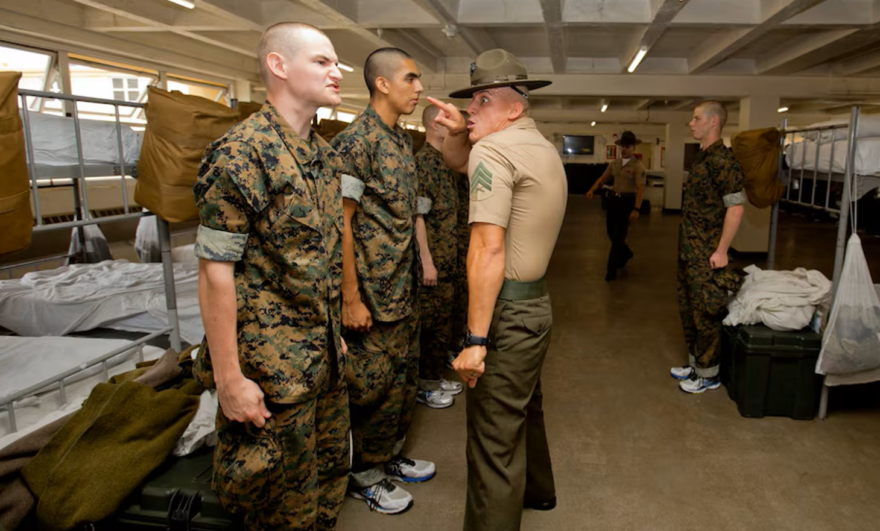Marine Corps boot camp is notorious for its rigorous training and high standards, and these factors contribute significantly to its attrition rates. To understand the dynamics behind these figures, it’s crucial to look at the statistics, the reasons for dropouts, and how these rates compare to other branches of the U.S. armed services.
Attrition Rates
Marine Corps boot camp typically experiences an attrition rate ranging between 10% to 15%. This means that out of every 100 recruits who start training, about 10 to 15 will not make it through to graduation. This rate is relatively high compared to other branches of the military. For instance, the Army has an attrition rate of around 9% to 11%, the Navy ranges from 6% to 10%, and the Air Force has the lowest at approximately 4% to 6%.
Attrition can be categorized into several key areas:
-Medical Issues: Around 30% of dropouts are due to medical reasons. Recruits may develop injuries or illnesses that render them unable to complete training. These can range from stress fractures to severe cases of dehydration or respiratory infections.
-Failure to Adapt: Another significant category is failure to adapt to the intense environment and mental strain of boot camp, accounting for approximately 25% of dropouts. This can include homesickness, inability to cope with the stress, or overall mental health issues.
-Physical Fitness: Physical fitness standards are exceptionally high in the Marine Corps, and about 20% of recruits who drop out do so because they cannot meet these standards. This includes failing to pass the Initial Strength Test (IST) or the Physical Fitness Test (PFT).
-Disciplinary Issues: Roughly 15% of attrition is due to disciplinary issues. This includes breaking rules, demonstrating poor conduct, or showing a lack of commitment to the Marine Corps’ values and expectations.
-Academic Failures: The remaining 10% can be attributed to academic failures. Recruits must pass various written tests on Marine Corps knowledge, and some fail to meet these requirements.
Physical Conditioning Platoons and Rehabilitation
For recruits who struggle with physical fitness, the Marine Corps has established Physical Conditioning Platoons (PCPs). Recruits who fail the IST or show insufficient physical progress are “dropped” into these platoons, where they undergo focused conditioning. The goal is to bring them up to the necessary fitness level so they can rejoin their regular training platoons. PCPs provide a structured environment focused solely on physical improvement, ensuring that recruits have the best chance to meet the demanding standards.
Special Training Platoons for Disciplinary Issues
In addition to PCPs, the Marine Corps also has Special Training Platoons (STPs) for recruits with disciplinary or attitude problems. These platoons provide a more controlled and intensive environment where recruits can be closely monitored and mentored. The emphasis in STPs is on correcting behavior, instilling discipline, and reinforcing Marine Corps values. Recruits in STPs receive additional guidance and counseling aimed at helping them reintegrate into regular training.
The Process Before Discharge
Before a recruit is discharged, several steps are taken to ensure that the decision is justified and all alternatives have been explored:
1. Counseling and Mentorship: Initially, recruits struggling with any aspect of training receive counseling and mentorship from their drill instructors. This support aims to help them overcome their challenges and continue with training.
2. Medical Evaluation: For those with medical issues, a thorough evaluation by military medical personnel determines if they can recover and continue or if they need to be medically discharged.
3. Review Boards: For more severe issues such as disciplinary problems or severe failure to adapt, the recruit’s case is reviewed by a board that includes senior officers and mental health professionals. They assess whether the recruit can be rehabilitated or if discharge is the best course of action.
4. Final Decision: The final decision to discharge a recruit is taken with careful consideration, ensuring that the recruit has been given every possible opportunity to succeed. This process ensures fairness and thoroughness.
Maximum Time at MCRD
There is a maximum time limit for how long a recruit can spend at Marine Corps Recruit Depot (MCRD). Generally, recruits are expected to complete boot camp within 13 weeks. If a recruit is held back for medical reasons, disciplinary issues, or physical conditioning, the total time at MCRD should not exceed one year. After this period, if the recruit has not met the necessary standards to progress, a discharge decision is typically made.
Comparing Attrition Across Armed Services
When comparing the Marine Corps’ attrition rate to other branches, it’s evident that the Marine Corps has a tougher standard. The Army’s slightly lower attrition rate can be attributed to a broader acceptance of recruits with varying physical and mental preparedness levels. The Navy and Air Force, with their lower attrition rates, also reflect different training focuses and perhaps less physical rigor compared to the Marine Corps.
The Marine Corps boot camp is designed to be one of the toughest military training programs, ensuring that only the most resilient and determined recruits make it through. The attrition rates reflect the high standards and rigorous demands placed on recruits. While other branches of the armed services also have rigorous training, the Marine Corps stands out for its particularly stringent requirements and the thorough process through which attrition is managed.
You got this!


 Our legacy lives through the stories we tell. The Suck Life wants yours! Make Chesty proud!
Our legacy lives through the stories we tell. The Suck Life wants yours! Make Chesty proud!



 Semper Fidelis
Semper Fidelis




I should live forever!